
The Battle of Almansa took place on 25 April 1707, during the War of the Spanish Succession. It was fought between an army loyal to Philip V of Spain, Bourbon claimant to the Spanish throne, and one supporting his Habsburg rival, Archduke Charles of Austria. The result was a decisive Bourbon victory that reclaimed most of eastern Spain for Philip.

"Els Segadors" is the official national anthem of Catalonia, nationality and autonomous community of Spain.

The Kingdom of Aragon was a medieval and early modern kingdom on the Iberian Peninsula, corresponding to the modern-day autonomous community of Aragon, in Spain. It should not be confused with the larger Crown of Aragon, which also included other territories — the Principality of Catalonia, the Kingdom of Valencia, the Kingdom of Majorca, and other possessions that are now part of France, Italy, and Greece — that were also under the rule of the King of Aragon, but were administered separately from the Kingdom of Aragon.

Catalans are a Romance ethnic group native to Catalonia, who speak Catalan. The current official category of "Catalans" is that of the citizens of Catalonia, an autonomous community in Spain and the inhabitants of the Roussillon historical region in southern France, today the Pyrénées Orientales department, also called Northern Catalonia and Pays Catalan in French.

The National Day of Catalonia is a day-long festival in Catalonia and one of its official national symbols, celebrated annually on 11 September. It commemorates the fall of Barcelona during the War of the Spanish Succession in 1714 and the subsequent loss of Catalan institutions and laws.

The Principality of Catalonia was a medieval and early modern state in the northeastern Iberian Peninsula. During most of its history it was in dynastic union with the Kingdom of Aragon, constituting together the Crown of Aragon. Between the 13th and the 18th centuries, it was bordered by the Kingdom of Aragon to the west, the Kingdom of Valencia to the south, the Kingdom of France and the feudal lordship of Andorra to the north and by the Mediterranean Sea to the east. The term Principality of Catalonia remained in use until the Second Spanish Republic, when its use declined because of its historical relation to the monarchy. Today, the term Principat (Principality) is used primarily to refer to the autonomous community of Catalonia in Spain, as distinct from the other Catalan Countries, and usually including the historical region of Roussillon in Southern France.

The Reapers' War, also known as the Catalan Revolt, was a conflict that affected a large part of the Principality of Catalonia between the years of 1640 and 1659. It had an enduring effect in the Treaty of the Pyrenees (1659), which ceded the County of Roussillon and the northern half of the County of Cerdanya to France, splitting these northern Catalan territories off from the Principality of Catalonia and the Crown of Aragon, and thereby receding the borders of Spain to the Pyrenees.
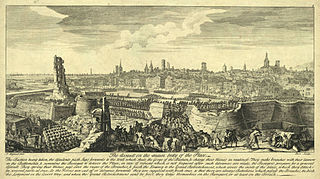
The siege of Barcelona was a battle at the end of the War of Spanish Succession, which pitted Archduke Charles of Austria against Philip V of Spain, backed by France in a contest for the Spanish crown.
Domènec Balmanya i Perera, also referred to as Domingo Balmaña, was a former Spanish football midfielder and manager who spent most of his playing career at FC Barcelona. As a manager, he guided CF Barcelona to the a Copa del Generalísimo win in 1957 and to victory in the first ever Fairs Cup in 1958. He then had moderately successful spells at Valencia CF, Real Betis and CD Málaga before he guided Atlético Madrid to a La Liga title in 1966. He subsequently managed Spain between 1966 and 1968. After retiring as a coach he worked as a director of sport at both RCD Espanyol and FC Barcelona and as a director at a Catalan coaching school. He also worked as a radio commentator.
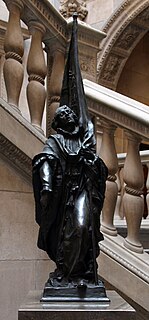
Rafael Casanova i Comes was a Catalan jurist and supporter of Charles VI, Holy Roman Emperor as a claimant to the Crown of Spain during the War of the Spanish succession. He became mayor of Barcelona and commander in chief of Catalonia during the Siege of Barcelona until he was wounded in combat while commanding La Coronela during the counterattack on the Saint Peter front on the last day of the siege, 11 September 1714. After the war he received a royal pardon for having supported the Habsburg claim to the Spanish throne. He recovered from his wounds, and continued his fight against absolute monarchy as a lawyer. It has been claimed that he is the author of the book Record de l'Aliança fet el Sereníssim Jordi Augusto Rey de la Gran Bretanya in which Catalonia reminds England of the Treaty of Genoa and their obligation to Catalonia.

Passeig de Gràcia is one of the major avenues in Barcelona (Catalonia) and one of its most important shopping and business areas, containing several of the city's most celebrated pieces of architecture. It is located in the central part of Eixample, stretching from Plaça Catalunya to Carrer Gran de Gràcia.

Carlos de Aragón de Gurrea y de Borja, 9th Duke of Villahermosa was a Spanish nobleman, viceroy and governor.

Arbúcies is a village in the province of Girona, in the autonomous community of Catalonia, Spain. The municipality covers an area of 86.24 square kilometres (33.30 sq mi) with a population of 6481 in 2014.
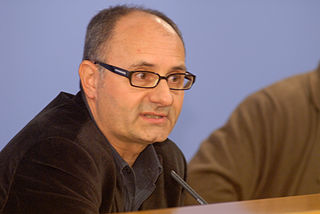
Joaquim Albareda Salvadó, is the chairing professor of modern history at Pompeu Fabra University (Barcelona) and former director of the Institut Universitari d'Història Jaume Vicens Vives at the same college. He is the head researcher of the research project España y los tratados de Utrecht (1712-1714), of the Spanish Ministry of Science and Innovation and Grup d’estudi de les institucions i de la societat a la Catalunya moderna . Director of the history collection publication Referències from Eumo Editorial. During last years he has focused his research on the topic of the War of Spanish Succession (1705-1714) and the political history of the 18th century.
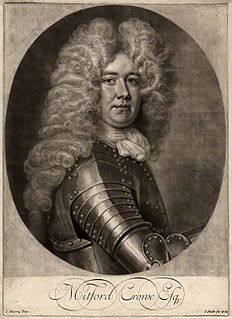
Colonel Mitford Crowe was an English diplomat, merchant, politician and colonial administrator who sat in the Parliament of England from 1701 to 1702 and served as the governor of Barbados from 1707 to 1710. He is best known for his career during the War of the Spanish Succession, where Crowe negotiated the Pact of Genoa with the Principality of Catalonia, which brought them into the Grand Alliance.

The Catalan Courts or General Court of Catalonia was the policymaking and parliamentary body of the Principality of Catalonia from the 13th to the 18th century.
Francesc de Castellví i Obando was a Catalan chronicler and historian who fought for the Austriacist side in the 1714 Siege of Barcelona. Castellví is primarily known for writing Narraciones Históricas during his stay in Austria, a work in which he explains the events that took place during the Siege of Barcelona based upon his own experiences.

The Battle of El Albujón was a confrontation between Bourbon troops under commandante Patricio Moran and corporal José Hernández and an English force backed by troops loyal to Charles VI. It took place on 21 September 1706 and formed part of the War of the Spanish Succession. It took part in the El Albujón district of the Spanish town of Cartagena and ended in a Bourbon victory. With the victory at the battle of Murcia, it led to the reconquest of Cartagena and evidenced the failure of the Austrian campaign in the kingdom of Murcia, a region of Castile.
Francisco Antonio Fernández de Velasco y Tovar, count of Melgar, was a Spanish noble and Viceroy of Catalonia.
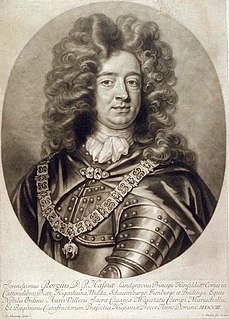
The Landing at Barcelona was a failed Allied attempt in May 1704 during the War of the Spanish Succession to capture the city of Barcelona from its Spanish pro-Bourbon defenders.

















